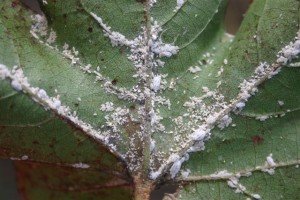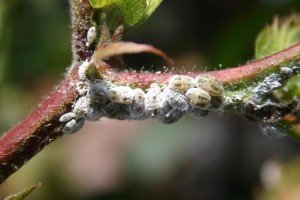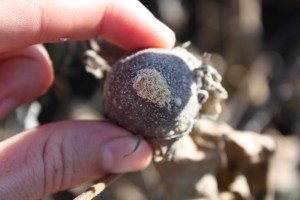Biosecurity Queensland has confirmed an outbreak of an exotic species of mealybug currently affecting cotton properties in Emerald is also present in cotton crops in the Burdekin region.
The exotic species of mealy bug is commonly known as the Solenopsis mealybug (Phenacoccus solenopsis).
The Solenopsis mealybug is a native of North America – first collected and described in New Mexico in 1897. In 1990, it was reported as a pest of cotton in Texas. From there it moved into Central and South America, and is now known to occur in Ghana, Nigeria, Israel, Pakistan, India, Indonesia, Thailand and China.
The Solenopsis mealybug is a polyphagous pest which means that it feeds and reproduces on a wide range of plants. In Pakistan it has been recorded on 154 plant species including field crops, vegetables, ornamentals, weeds, and trees.
Other key reasons for the fast spread and difficulty to control this pest include:
• The bugs possess a waxy coating that protects them from insecticides and natural mortality factors
• They have a high reproductive rate
• They have the ability to hide in soil cracks and crevices.
• They are spread through natural carriers such as raw cotton seeds, wind, water, rain, birds, humans, farm equipment and animals.
Identification and lifecycle of the Solenopsis mealybug
The female mealybug is wingless with a 3-4 mm long oval shaped body which is covered with white hydrophobic (water repellent) mealy wax. There are dark bare spots on the thorax and abdomen, which appear as dark longitudinal lines.
The adult male is about 1 mm long, with a grey body and a single pair of transparent wings. Two filaments of white wax project from the end of its abdomen. The adult male has no feeding mouthparts and causes no damage.
Mature females lay eggs in waxy pouches called ovisacs. Each ovisac contains between 150- 600 eggs, the majority of which are female. The eggs hatch after three to nine days into nymphs called ‘crawlers’, which are very mobile.
No parthenogenesis (asexual reproduction) is reported in the literature and therefore it is assumed that the species reproduces through sexual reproduction.

Male crawlers undergo three larval instars over 13–17 days before spinning a cottony cocoon in which it passes a pupal stage for 6-8 days. A male adult lives for only 3-5 days. Mealybugs can have 12–15 generations in a year.
The species (as eggs in ovisacs or in other life stages) can survive cold conditions, both on the host plant and in the soil. In warm climates, mealybugs reproduce all year round.
Mode of damage
Mealybugs have sucking mouth parts at all stages of their life cycle, which they use to extract large amounts of plant sap. During the feeding process a significant amount of sap oozes out as honeydew which forms a sticky deposit on the leaves and stem. Honeydew promotes the growth of sooty mould fungi which inhibit photosynthesis.
Symptoms of plants infested during the vegetative phase include:
• Distorted and bushy shoots
• Crinkled and/or twisted and bunchy leaves
• Stunted plants that dry completely in severe cases.
Symptoms of late season infestations during the reproductive crop stage include:
• Fewer, smaller and deformed bolls
• Reduced plant vigour
• Early crop senescence.
Mealybugs can also stain cotton lint and reduce quality hence this pest has the ability to cause damage to both the quality and quantity of cotton.
Methods of spread
Mealybugs are generally disseminated as crawlers. The crawlers can move from an infected to a healthy plant as well as infected field to adjacent healthy fields. While this type of movement is localised, bugs have the means to travel long distances and infest new areas. The waxy coating on the mealybug crawlers facilitates passive transport of the insect by sticking onto equipment, other insects (e.g. bees), birds, animals or people. Small crawlers are also readily transported by wind and rain or in water in irrigation channels. Long-distance movement through the transport of infested plants is also possible.
Ants are also a significant factor in the spread of mealybugs. In return for providing the honey dew that the ants feed on, they spread the mealybugs, protect them from natural enemies and keep their colonies clean.
Clusters of tiny crawlers – ready for dispersal (image by Zara Ludgate)
Management of mealybugs
There are no insecticides registered for the control of mealybugs in cotton. However there are a number of management options that can reduce infestations and the overall impact of this pest.
• Mealybugs multiply on different hosts and may initially breed on weeds before migrating to cotton crops
• Weeds in and around fields should be removed.
• Do not throw uprooted weeds into water channels.
• The removal of affected plants at the early stage of infestation may reduce mealybug numbers in the rest of the crop.
• Avoid physical contact with infested plants as mealybugs easily adhere to clothing and implements.
• Practice good farm hygiene and clean all equipment that has been in affected fields.
• Consider the insecticides that are used in control of other insect pests to conserve natural enemies of mealybugs.
Trials in Pakistan and India show some promising results in terms of suitable insecticides. Insecticide trial work to control mealybug will commence in Queensland in the near future.
The main priority at this point is to try and limit further spread of the mealybug from and within the Emerald and Burdekin areas. With harvesting of crops to commence soon in the Emerald area, the Queensland Government is working closely with the cotton industry to develop wash-down and decontamination protocols for harvesting machinery. More information about these protocols will be provided in a blog next week.
Biological control
A survey in Pakistan recorded as many as nine species of predators feeding on Solenopsis mealybugs. These predators were present throughout the cotton season but their effectiveness was not sufficient to keep mealybugs under control.

Meanwhile in India, a small wasp (Aenasius bambawalei) is reported to parasitise about 60 percent of the mealybug population under field conditions.
Article by Kate Charleston and David Murray. Images by Zara Ludgate and Greg Kauter.




Mealybug, Phenacoccus solenopsis had been a serious cotton pest in Pakistan between 2005 and 2008. In 2009 and now in 2010 mealybug population is completely under control in almost all the cotton growing areas of Pakistan. The major factor in suppressing mealybug population is Aenasius bambawalei, an encyrtid parasitoid. A huge biological control program of cotton mealybug is in place in Pakistan which mainly rely on mass rearing and release of A. bambawalei and a predator, Cryptolaemus sp. The mass rearing of A. bambawaei is under threat due to its recently discovered hyperparasitoid. Correct identification of the hyperparasitoid has not been confirmed yet in Pakistan.
We have reported several parasitoids emerging from mummies of Phenacoccus solenopsis in India. These were Aenasius bambawalei Hayat, Promuscidea unfasciativentris Girault, Myiocnema comperei Ashmead, Prochiloneurus albifuniculus (Hayat, Alam and Agarwal) and Marietta leopardina Motschulsky. Among these A. bambawalei is the only primary parasitoid and rest others are hyperparasitoids of A. bambawalei. M. compere dominated among the hyperparasitoids. An unidentified eulophid was also recordrd. A. bambawalei provided complete control of P. solenopsis on cotton in Haryana, India. (Journal of Biological Control, 24 (2): 104–109, 2010)
In India we have at least two effective parasitoids viz., Aenasius bambawalei Hayat (Encyrtidae) and Promuscidea unfasciativentris Girault (Aphelinidae) that suppressed P.solenopsis, in addition to generalist predators.
I am sure that brown pirate bugs are eating crawlers. I can find 2 – 3 pirate bugs in squares and evidence of dead mealys.